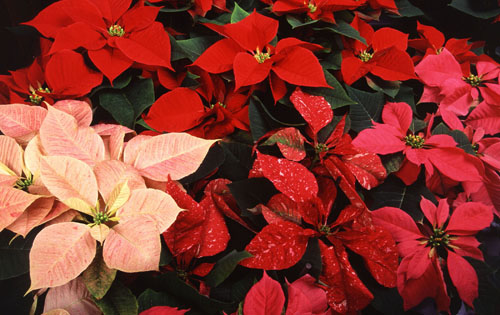Despite their limited, two-month run on retailers' shelves each year, poinsettias are the best-selling potted plant in the United States. Growers sold more than 34.6 million plants in 2014 alone.
But that popularity doesn’t always translate into longevity. Come February or March, many of these cherished decorations are droopy, yellowed or worse — in the trash.
Poinsettia plants can last for years if they are treated right, said Paul Thomas, professor of horticulture at the University of Georgia College of Agricultural and Environmental Sciences.
Here are Thomas’ top tips for caring for poinsettias:
- Before you buy a poinsettia, inspect it to make sure it has strong, sturdy stems, dense foliage all the way down its stems, that its bracts (colored leaves) have no blemishes and that its small yellow flowers have just barely opened. You can also carefully remove the plant from its pot to inspect the plant’s root system. If the plant has just a few roots or lots of dark brown roots, don’t buy it. Healthy poinsettias have plenty of tan and white roots.
- These plants are susceptible to root rot, so don’t overwater them or let them sit in water filled saucers. The holiday foil that florists wrap around some poinsettia pots can trap water in the pot, so it’s best to remove it. Only water the plant when the soil surface feels dry, and add water just until water drains out of the bottom of the pot.
- Poinsettias prefer warm temperatures and full sun, but they can spend a few weeks on a fireplace hearth or in the shade of a Christmas tree with the proper care. “During the holidays, you can place poinsettias just about anywhere to liven things up,” Thomas said. “They'll last about three weeks in fairly dark places. “While it's in the dark, water only when the soil is dry. And don't fertilize it. Overwatering or fertilizing your poinsettia during the holidays when it is in dark conditions is the most common cause of rapid death.”
- After the holidays, poinsettia caregivers should move them to a sunny window and apply a little houseplant fertilizer. “The bracts may begin to fall off fast,” Thomas said. “This is normal. If they last until March, your poinsettia was very happy where you put it.” In April cut the plant back to about 10 inches or until there are four to six nodes of the stem above the soil. “At this point, the poinsettia can be grown (in Georgia) outdoors in full sun,” Thomas said. “If watered and fertilized, poinsettias will grow great outdoors. Trim them in June and plant them in 1-gallon pots or large indoor planters.”
- An outdoor poinsettia needs to be fertilized every week with a basic houseplant fertilizer during the spring and summer. “If watered and fertilized properly, poinsettias will grow quite large, as high and wide as 5 feet,” Thomas said.
- To force your repotted poinsettia to bloom, cover the plant after 6 p.m. starting September 22 and uncover it at 7 a.m. Do this until about November 10. This process will trigger the poinsettia to make new, colorful bracts and flowers just in time for the holidays.









